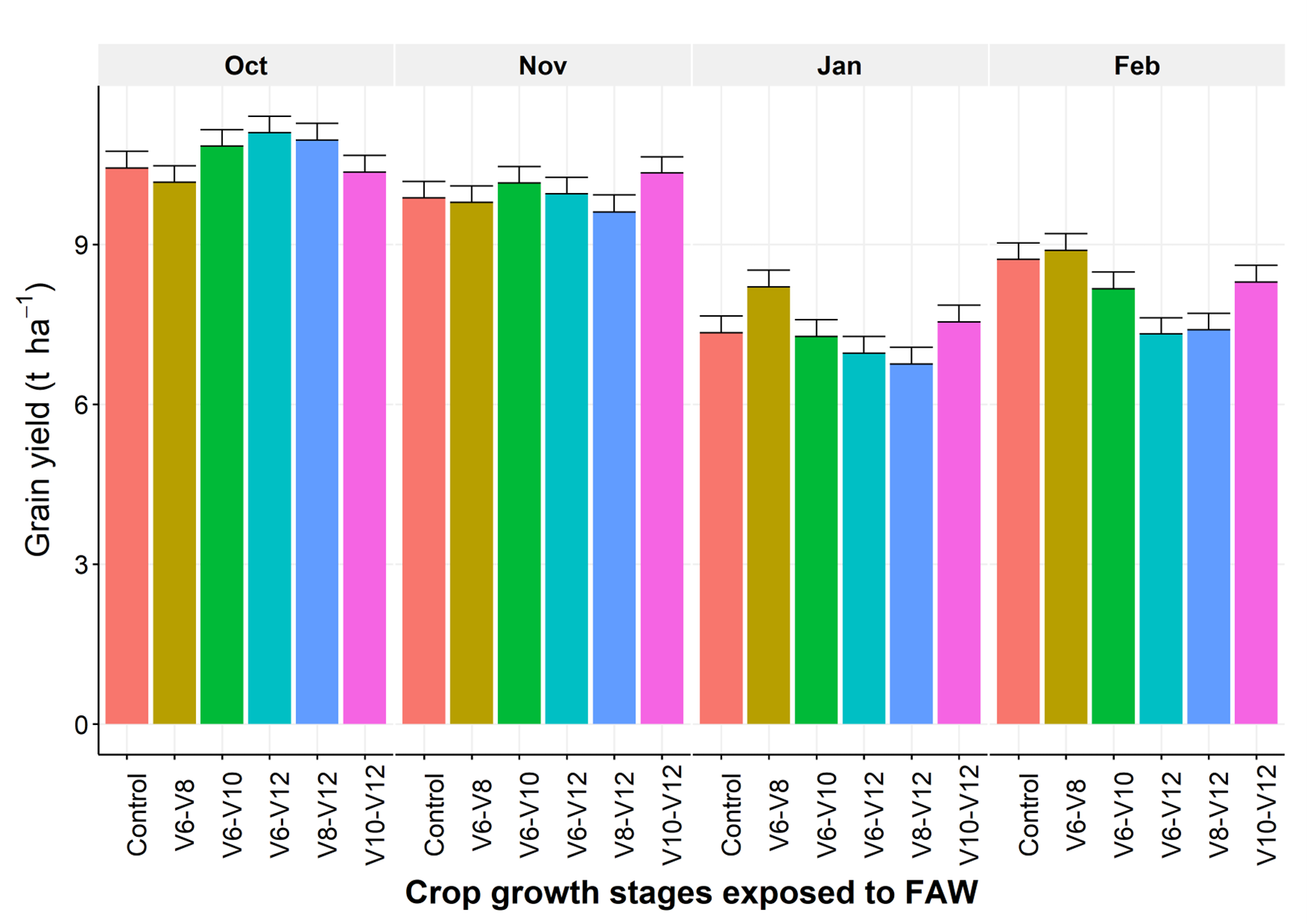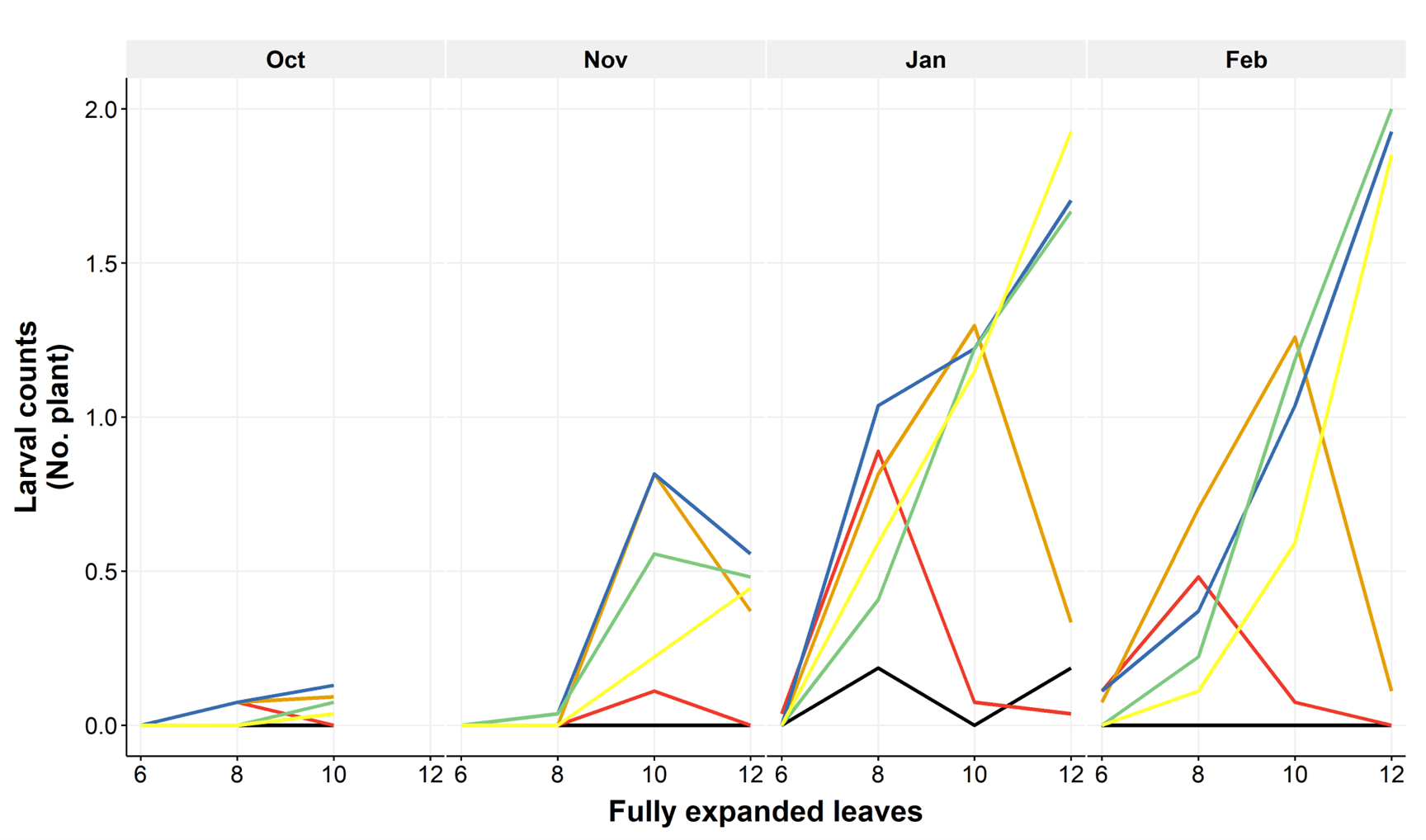Establish Australian economic management thresholds for Fall Armyworm in maize (rainfed and irrigated) and sorghum
Take home message
- Sorghum grain yield reductions of up to 16% or 1.2 t/ha occurred when the crop with 10 to 12 fully emerged leaves was infested with high densities of large larvae (5 or 6th instar)
- Sorghum defoliation due to FAW infestation doesn’t always cause yield losses and ongoing research is investigating contributing factors
- Medium to large sized FAW larvae can cause seedling death so all seedlings were protected from FAW for this research.
Introduction
The decision to control fall armyworm (FAW) infestations in sorghum before sorghum and maize flower requires information on the dynamic nature of crop yield variability associated with season-to-season variability and FAW loss potential. Existing control thresholds for FAW are static, based on crop defoliation levels, but defoliation has a poor correlation with yield loss. So even though existing thresholds are valid and useful they could be substantially improved. Crop models account for the environmental and management variability that contributes to yields for a wide range of crop canopy sizes. So, establishing the relationship between crop growth stage and FAW infestation intensity on defoliation provides a physiological basis to initiate crop canopy size potential in crop models and sensibly predict crop yield and losses. Understanding the influence of crop management practices and environmental conditions on the likelihood and potential magnitude of yield limiting FAW infestation will inform the most cost-effective control action.
What is presented in this paper are updates on FAW impacts on sorghum grain yield that will assist in understanding of best-bet management strategies that will be refined as there is more research and experience with this new pest.
Methods
The 2022/23 field crop experiment at Gatton was designed to understand the effects of FAW infestation density, crop growth rate and timing of natural FAW infestation relative to crop canopy development stage on potential maize and sorghum yield formation. Growth rate and FAW density treatments were imposed by manipulating:
- plant-to-plant competition with different levels of plant population density and,
- sowing dates targeting expected increases in FAW pressure (Table 1).
Table 1. Sorghum crop development timing for each sowing date treatment.
Treat ID | Sowing | Emergence | Flowering | Maturity |
1 | 11-Oct | 17-Nov | 20-Dec | 14-Feb |
2 | 7-Nov | 12-Nov | 8-Jan | 8-Mar |
3 | 17-Jan | 22-Jan | 14-Mar | 9-May |
4 | 3-Feb | 7-Feb | 27-Mar | 26-May |
FAW infestations were effectively controlled with insecticides for all treatments up until the crop was at V6 stage to ensure the crop population density was unaffected by FAW. Then crops were exposed to natural FAW infestations for pre-defined periods coinciding with key crop development stages.
FAW infestations were monitored by destructively sampling three plants per plot at the V4, V6, V8, V10 and V12 crop development stages and recording the number of instars per plant. Non-destructive Davis scores were also evaluated on 8 sentinel plants per plot. These sentinel plants were harvested at maturity and yield components recorded.
Results
Grain sorghum yield loss of 1.2 t/ha or 16% was observed in the treatments exposed to natural FAW infestations between the V6 and V12 crop development stages compared with control plots for the February sown treatments (Figure 1). The magnitude of yield loss increased from 0.0, 0.0, 0.5 to 1.2 t/ha as treatments were progressively sown later from October, November, January and February, respectively (P≥0.001 for the sowing time by FAW exposure treatment interaction).

Figure 1. The effect of natural FAW infestations on sorghum grain yield at four different crop sowing times
(11-Oct, 7-Nov, 17-Jan, 3-Feb). Natural FAW infestations were controlled to coincide with crop development stages. V stages indicate the number of fully expanded leaves on the main stem.
The FAW infestation density also increased with progressively later sowing date (Figure 2). Few large FAW were found on the October and November sowing dates for any FAW exposure period. However, 1 to 2 large FAW (5 or 6th instar) established on each plant for both the January and February sowing dates.

Figure 2. The average number of large FAW larvae (5 or 6th instar) per sorghum plant relative to the number of fully expanded leaves on the main stem. Colours show the different FAW exposure periods. No exposure control = black, red = V6-V8, orange = V6-V10, blue = V6-V12, green = V8-V12, yellow = V10-V12.
Discussion and conclusion
Sorghum grain yield loss was associated with prolonged exposure to FAW starting from V6 and V8 crop development stages and establishing 1 to 2 large FAW instars (5th or 6th) per plant by the time 10 to 12 leaves had expanded on the main stem. Both the January and February sowing dates had similarly high levels on FAW infestation, but the magnitude of yield loss was 0.5 and 1.2 t/ha, respectively. It is possible that other factors reduced the impact of FAW in the January sown treatments as the crop harvest index was low. On-going research is exploring the effect of environment on FAW yield loss potential and how crop simulation modelling can better inform economic control thresholds.
These crops were grown without water and nutrient limitations needed to characterise FAW potential to impact yields. It is unclear how FAW infestations of already water or nutrient stressed crops impact yield. On-going research is exploring how temperature and sunshine interacts with FAW damage to impact the yield loss magnitude and how existing crop models can predict the yield loss magnitude across a range of production systems and environments to inform economic thresholds.
Interim results suggest that FAW control should be considered when medium to large FAW (4th to 6th) are present on seedlings i.e. crops with less than 6 fully emerged leaves on the main stem. FAW control should also be considered when FAW infestations begin to damage crops at V6 to V8 development stage and establish greater than 1 large larva (5th to 6th instar) as the 10th leaf fully expands.
Acknowledgements
The research undertaken as part of this project is made possible by the significant contributions of growers through both trial cooperation and the support of the GRDC, the author would like to thank them for their continued support.
The Queensland Government has invested in a rapid response to support industries impacted by FAW (2020–23). This investment supports research, insecticide resistance monitoring (2022–23), extension and skills development for industry and researchers.
Michael Ashcroft provides technical support to FAW field and laboratory activities.
Contact details
Melina Miles
Queensland Department of Agriculture and Fisheries
203 Tor St, Toowoomba Qld. 4350
Ph: 0407 113 306
Email: melina.miles@daf.qld.gov.au
Joseph Eyre
Queensland Alliance for Agriculture and Food Innovation
The University of Queensland, Gatton, Qld
Ph: 0467 737 237
Email: j.eyre@uq.edu.au
Date published: July 2023
GRDC Project Code: DAQ2107-002RTX,
Was this page helpful?
YOUR FEEDBACK
